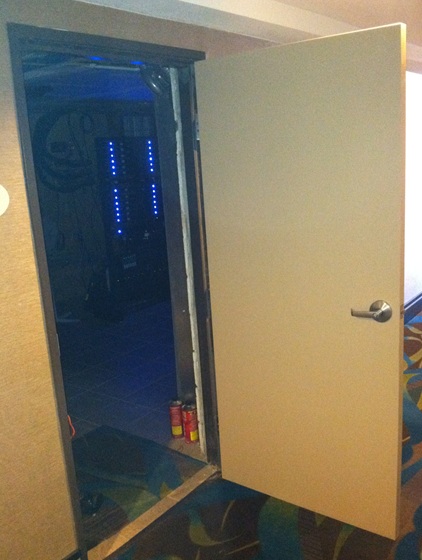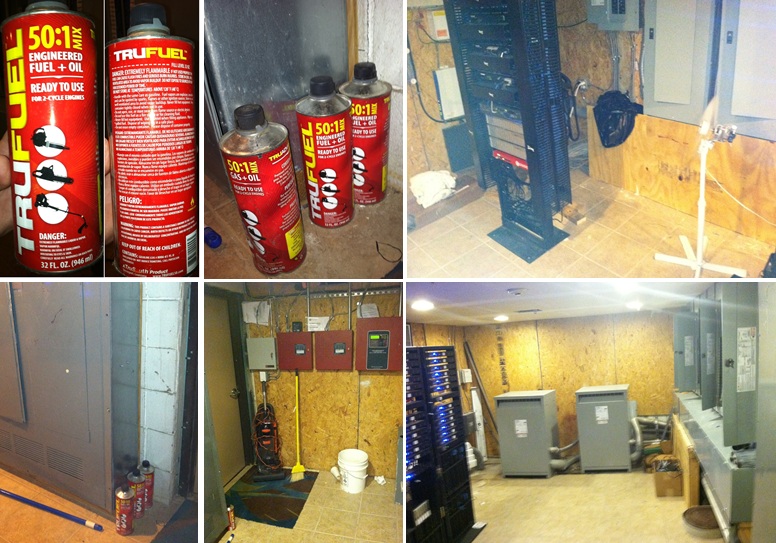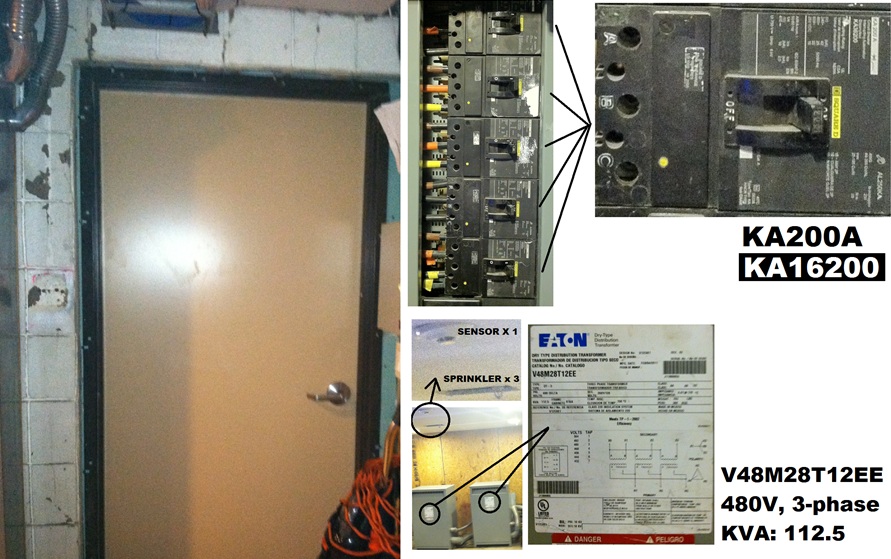UPDATE: This application was discussed at length on the Building Codes Forum, so go check it out to see what the AHJs had to say. The final decision was that the door should have been a 20-minute door, even if the contents of the electric room did not require a higher rating. As a 20-minute door it should have been self-closing and self-latching.
I received this email today and I am publishing it verbatim with permission from the author. What are your thoughts? Please leave a comment!
Hi Lori,
I love your site! I train “in-house” locksmiths in facilities across the country. I bring awareness to Life Safety 101 and NFPA 80 to Institutional Locksmiths who work in multiple levels of government and large private corporations. I get the opportunity to travel to many highly occupied buildings and like you I can’t help but keep a critical eye on passive fire protection systems, life safety issues, and ADA concerns.
I am currently staying in a hotel in Texas that is only a year old. In my opinion, the poor installation of the door hardware and (in regards to door openings) the inexperience of the punch list team to correct poor installations has caused a rapid decay of the lifesaving designs in modern openings.
During a walk-through of the hotel I noticed the cylindrical lock on the electrical room was not latched. I opened the door and saw three full 32-ounce cans of 50:1 fuel/oil on the floor. I could immediately feel the heat generated from the emissions of the electrical components escaping the room. This room is in the middle of the 3-story hotel that is surrounded on all four sides by a route of egress corridor that is shared with the rooms on that floor. You can see a fan that is pointed towards one of the servers to minimized the overheating network issues. The opening is not rated and there is no self-closing device on the door. You can see in the photos that the walls are not finished and have combustible OSB exposed.
Without seeing the building plans I cannot see why this area would not be better designed to protect the exit corridor that surrounds this room. Could this area have been approved to not need a fire door? Even when you remove the fuel cans from the area I still have concerns that the electrical room in the center of the building is a high hazard area. The obligation of a of a Fire Door Assembly Inspector is to observe and report to the owner and AHJ. There is some additional research that a FDAI would need to do including reviewing the building plans. What are yours and your readers thoughts?
Chad Jenkins, FDAI
National Locksmithing Institute
2820 N. Pinal Ave., Ste. 12, Casa Grande, AZ 85122
Phone: 888.682.0522 Fax: 602.391.2120
chad@nationallocksmithing.com
You need to login or register to bookmark/favorite this content.









First of all, Wow! I love the fuel cans in the room with heat. I am surprised this room is not fired rated, or at least smoke rated which would require smoke gasketing and door closer. Just curious, what was the size of this room? The door doesn’t latch which is not a good thing, so if there ever is a fire the door blows open. As Chad pointed out in the photo’s if there ever were a fire it would appear the room would go up pretty quickly by the looks of the construction material and the way the room was built. Something doesn’t seem right here. I wonder if on the original floor plans they called this room something else (like storage) to pass inspection, then move all of this equipment in at a later time. I would think someone in management of the hotel chain should be made aware of this potential problem.
I’m not sure what Chad’s question is, but here are some initial thoughts:
1). While it is not a good idea to store sealed containers of flammable liquids in a server room that produces heat, I don’t believe it is a code violation. NFPA 30 allows up to 1 gallon of Type I flammable liquids to be stored in its original sealed container provided the aggregate total of flammable liquids does not exceed 1 gallon. 3 – 32 oz. cans is less than 1 gallon, so that is not a code violation.
2). If the server room door did not latch, then technically, the contents of the room are open to the corridor, and storage of flammable liquids (even in the sealed 32 oz. cans) is not permitted. I don’t see where the server room has to be fire rated with less than 1 gallon of the flammable liquids, just be separated from the corridor.
3). I would report this issue to the front desk and if they did not have the flammable liquids removed immediately (and stored outside of the hotel), I would check out and find another place to stay.
Them are my thoughts….
After reading Chad’s comments once more, I would offer to Chad that an electrical room with servers, transformers and electrical distribution panels does not constitute a high hazard. As an AHJ, I would not consider it to be a hazardous room at all, even though I’m sure it gets warm in there. Wood and paper products do not combust until the temperature is over 1200 degrees F, so I don’t think they have anything to worry about.
But that’s just me… Who knows what the next AHJ would say.
John, I had the same feeling; wow! The room is 12’x19′. I would suspect the purpose of the room is the same as the plans for the following reason: every control wire for the hotel appears to run through this room. The fire alarm control panel, phone system, network system, and breaker panels are all housed in this room. Fortunately the hotel is leaving this room unlocked so it get the attention it needs from a nosy patron 🙂
These and similar instances, that are powder kegs, must be highlighted in our presentations to the fire fighting community, code official, and building approvers. So that preventive measures are taken under expert guidance from door & hardware professionals.
This is a problem. Locksmiths need a book pertaining to their specific state, city,etc. To be able to bring certain rules,regs to clients to prove what is code and violations. It all being on a national new “code” is too confusing and takes forever to gather the correct ruling for your geographical area. I ‘m in NYC. If you ask 5 other locksmiths for the correct code, you will get 5 different answers.
Both the IBC and NEC require exit devices on electrical room doors with equipment rated 1200 Amp or more. The door should open out (which it does) – the idea being that a semi-paralyzed person can fall against the door and get out.
Code also says that if the building is sprinkled this room doesn’t need to be fire rated.
oh, there you go.. electricity and water won’t “mix”… lolol
I’m not sure if my IT consultant would like the mixing of systems. unless this is high amperage (1200) my recollection is that panel rooms don’t require a rating. Usually we provide some type of ventilation for the electric equipment.
The user of building do all sorts of dumb things, hope the building is sprinklered.
Remind me not to stay in that hotel.
David
cannot say construction material correctly,
But looks like the door is in a CMU/brick wall
Look at the botton left picture
A couple of things will trigger an electrical room to be fire rated. From the photo, that room could very possibly require a rated enclosure. One thing that would do it is if any transformer exceeded 112.5 kVA. I see two transformers there, so it is a possibility. I would not be surprised at all if there is no need for special protection from an NEC, NFPA 101, 1, or IBC/IFC standpoint.
The room certainly does look strange, I certainly would have done a double take. There’s also a big difference between a door that “doesn’t latch” and a door where the latch needs some TLC.
Always stay in a sprinklered hotel.
Language is such a problem. Most folks assumed that the door could not latch. Maybe it was just not fully closed and would latch if fully closed. Then considering the contents of the room and the information contained in the computer equipment, the hardware consultant/security consultant/doorhardware installer/whomever was responsible for the lack of a closer; did the owner a huge disservice. There was no door closer installed, the door is not fire rated and therefore there is no statutory requirement for a door closer, but that doesn’t mean that there should not be a door closer.
I’ve read all comments so far..all interesting and valid,thought provoking comments.Speaking strictly as a locksmith, from my locksmith brain, not my door inspector brain, that door should be closed and locked at all tmes.Should have a sign “staff only”.
The mngr. of that building should be more intune with security,safety and liability.
shoulda ‘named’ ’em to ‘shame’ ’em. hehehe. Texas… rolling eyes…